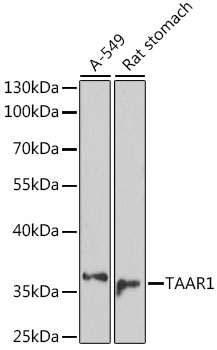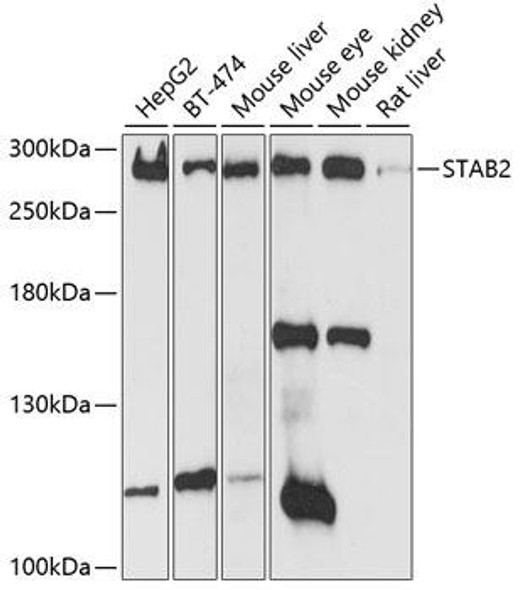Anti-TAAR1 Antibody (CAB16166)
- SKU:
- CAB16166
- Product type:
- Antibody
- Reactivity:
- Human
- Mouse
- Rat
- Host Species:
- Rabbit
- Isotype:
- IgG
- Antibody Type:
- Polyclonal Antibody
- Research Area:
- Cell Biology
Frequently bought together:
Description
| Antibody Name: | Anti-TAAR1 Antibody |
| Antibody SKU: | CAB16166 |
| Antibody Size: | 20uL, 50uL, 100uL |
| Application: | WB |
| Reactivity: | Human, Mouse, Rat |
| Host Species: | Rabbit |
| Immunogen: | A synthetic peptide corresponding to a sequence within amino acids 100-200 of human TAAR1 (NP_612200.1). |
| Application: | WB |
| Recommended Dilution: | WB 1:500 - 1:2000 |
| Reactivity: | Human, Mouse, Rat |
| Positive Samples: | A-549, Rat stomach |
| Immunogen: | A synthetic peptide corresponding to a sequence within amino acids 100-200 of human TAAR1 (NP_612200.1). |
| Purification Method: | Affinity purification |
| Storage Buffer: | Store at -20°C. Avoid freeze / thaw cycles. Buffer: PBS with 0.02% sodium azide, 50% glycerol, pH7.3. |
| Isotype: | IgG |
| Sequence: | TSTD IMLS SASI FHLS FISI DRYY AVCD PLRY KAKM NILV ICVM IFIS WSVP AVFA FGMI FLEL NFKG AEEI YYKH VHCR GGCS VFFS KISG VLTF MTSF Y |
| Gene ID: | 134864 |
| Uniprot: | Q96RJ0 |
| Cellular Location: | Cell membrane, Multi-pass membrane protein |
| Calculated MW: | 39kDa |
| Observed MW: | 39kDa |
| Synonyms: | TAAR1, TA1, TAR1, TRAR1 |
| Background: | The protein encoded by this gene is a G-protein coupled receptor activated by trace amines. The encoded protein responds little or not at all to dopamine, serotonin, epinephrine, or histamine, but responds well to beta-phenylethylamine, p-tyramine, octopamine, and tryptamine. While primarily functioning in neurologic systems, there is evidence that this gene is involved in blood cell and immunologic functions as well. This gene is thought to be intronless. |
| UniProt Protein Function: | TAAR1: Receptor for trace amines, including beta- phenylethylamine (b-PEA), p-tyramine (p-TYR), octopamine and tryptamine, with highest affinity for b-PEA and p-TYR. Unresponsive to classical biogenic amines, such as epinephrine and histamine and only partially activated by dopamine and serotonine. Trace amines are biogenic amines present in very low levels in mammalian tissues. Although some trace amines have clearly defined roles as neurotransmitters in invertebrates, the extent to which they function as true neurotransmitters in vertebrates has remained speculative. Trace amines are likely to be involved in a variety of physiological functions that have yet to be fully understood. The signal transduced by this receptor is mediated by the G(s)-class of G-proteins which activate adenylate cyclase. Belongs to the G-protein coupled receptor 1 family. |
| UniProt Protein Details: | Protein type:GPCR, family 1; Receptor, GPCR; Membrane protein, integral; Membrane protein, multi-pass Chromosomal Location of Human Ortholog: 6q23.2 Cellular Component: plasma membrane; integral to membrane Molecular Function:G-protein coupled receptor activity; trace-amine receptor activity Biological Process: G-protein coupled receptor protein signaling pathway |
| NCBI Summary: | TAAR1 is a G protein-coupled receptor activated by trace amines. Trace amines are endogenous amine compounds that account for less than 1% of the biogenic amines in most brain regions (Bunzow et al., 2001 [PubMed 11723224]).[supplied by OMIM, Mar 2008] |
| UniProt Code: | Q96RJ0 |
| NCBI GenInfo Identifier: | 21264324 |
| NCBI Gene ID: | 134864 |
| NCBI Accession: | NP_612200.1 |
| UniProt Secondary Accession: | Q96RJ0,Q2M1W5, Q3MIH8, Q5VUQ1, |
| UniProt Related Accession: | Q96RJ0 |
| Molecular Weight: | 39,092 Da |
| NCBI Full Name: | trace amine-associated receptor 1 |
| NCBI Synonym Full Names: | trace amine associated receptor 1 |
| NCBI Official Symbol: | TAAR1 |
| NCBI Official Synonym Symbols: | TA1; TAR1; TRAR1 |
| NCBI Protein Information: | trace amine-associated receptor 1; taR-1; trace amine receptor 1 |
| UniProt Protein Name: | Trace amine-associated receptor 1 |
| Protein Family: | Short-chain dehydrogenase reductase |
| UniProt Gene Name: | TAAR1 |
| UniProt Entry Name: | TAAR1_HUMAN |









